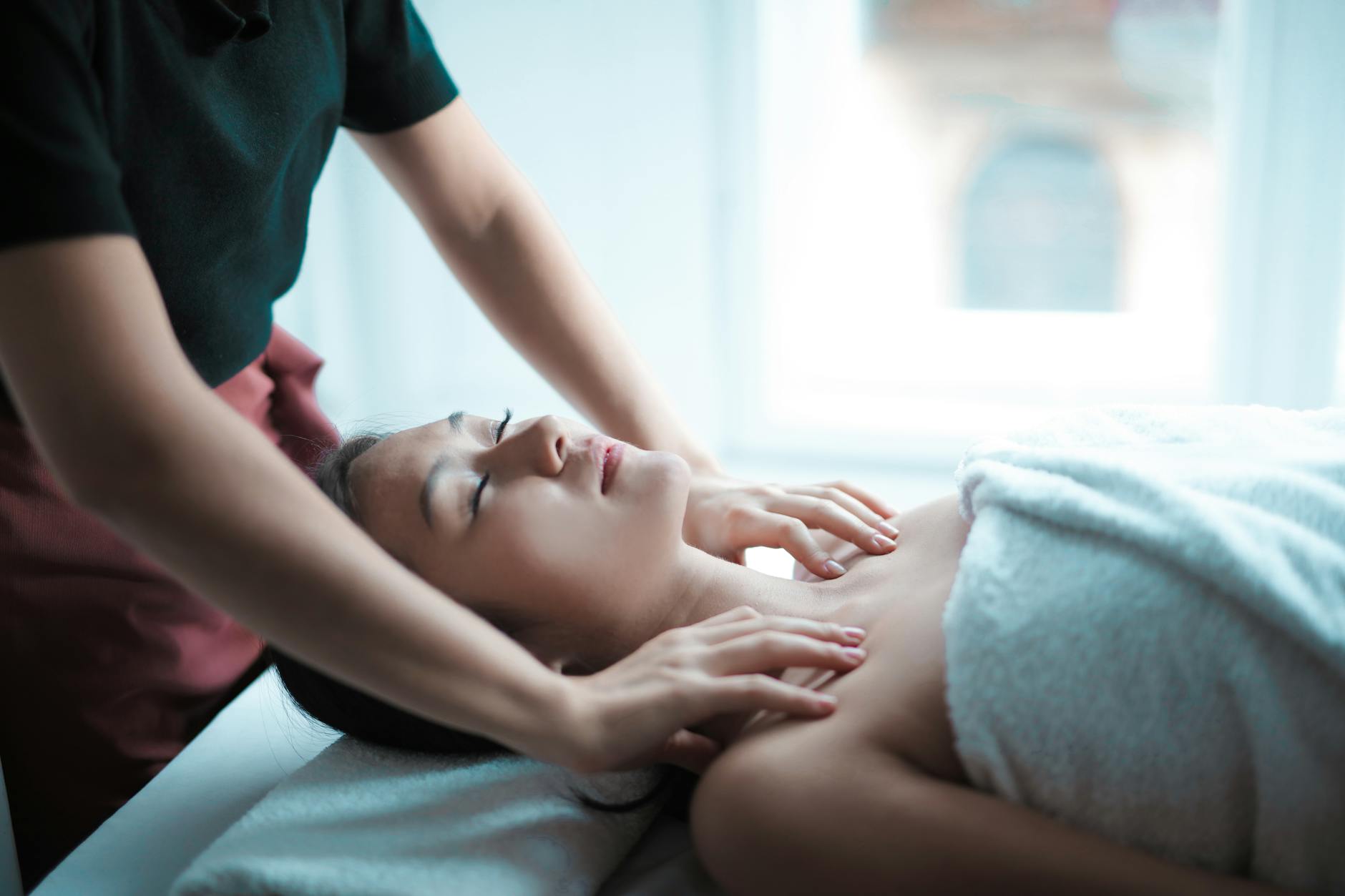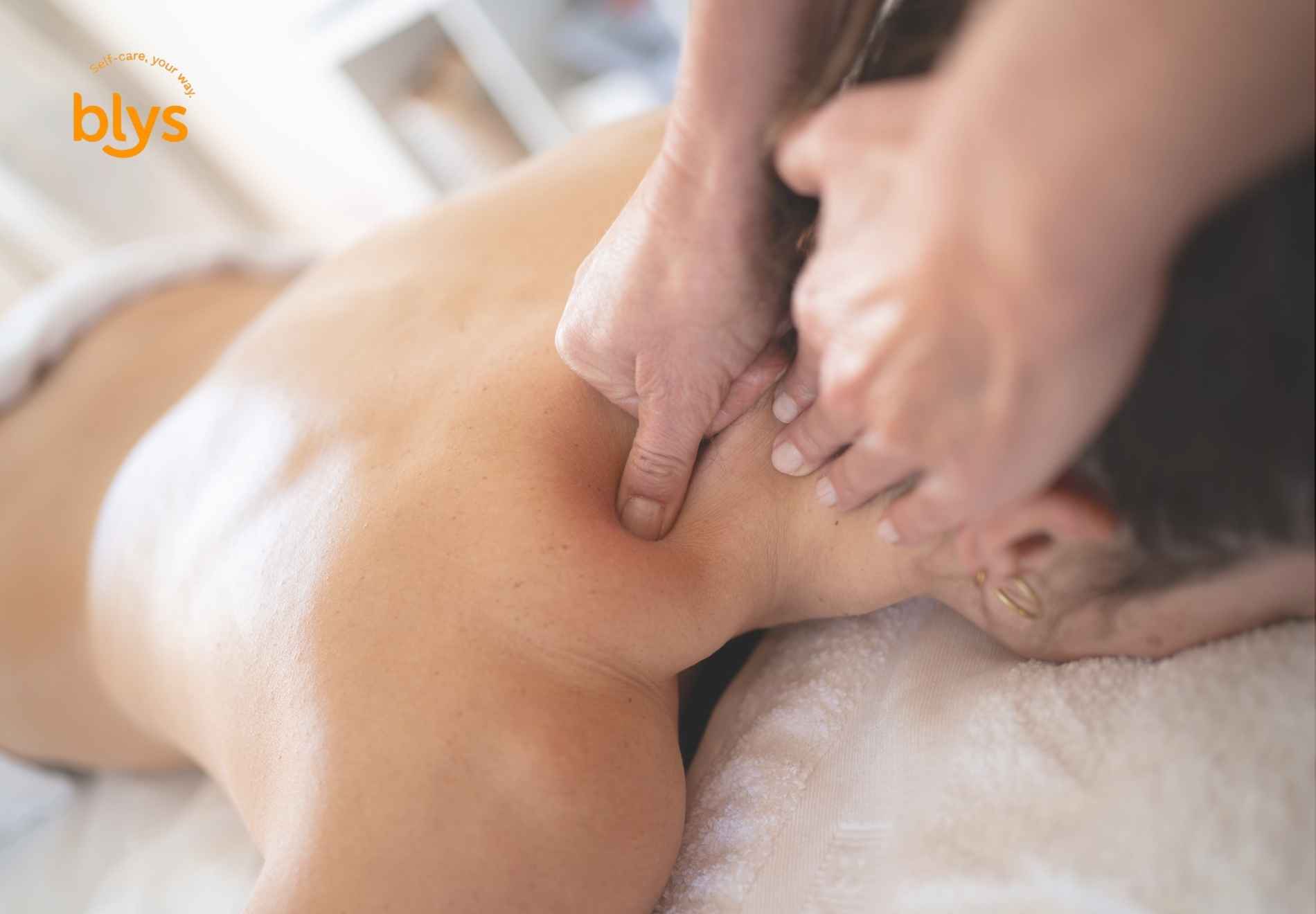
Understanding Trigger Points in Shoulder Muscles
What Are Trigger Points in Shoulder Pain?
Trigger points are basically when a specific area on a shoulder muscle gets irritated and tightens up into a ball or knot. It can cause ongoing muscle pain that may radiate to other areas, limit mobility, and lead to discomfort during everyday activities, making it difficult to perform tasks such as lifting, reaching, or even resting comfortably.
For a detailed guide on trigger point massage, check out our blog on What is Trigger Point Massage?
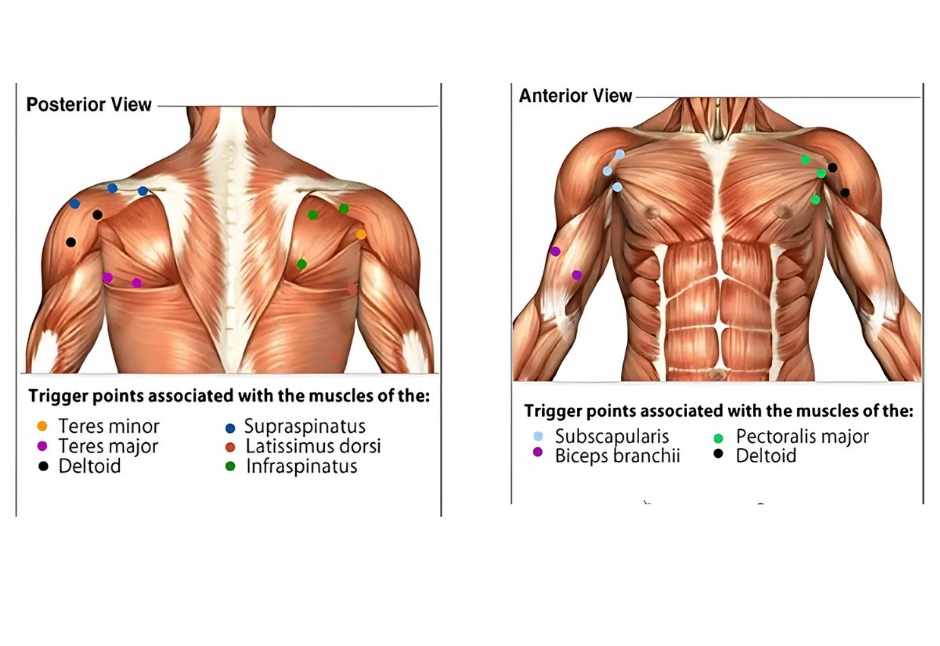 Common Trigger Points Causing Shoulder Pain
Common Trigger Points Causing Shoulder Pain
The following are the trigger points that cause shoulder pain, and the right trigger point therapy helps alleviate the pain. Although there are five of them listed below, the most commonly affected muscle groups are infraspinatus, subscapularis, and trapezius.
| Trigger Points | Referred Pain Areas |
| Infraspinatus | Down the arm, left or right shoulder |
| Supraspinatus | Top of the shoulder, down the arm |
| Teres Minor | Back of the shoulder, upper arm |
| Subscapularis | Front of the shoulder, into the chest |
| Upper Trapezius | The base of the skull, upper back |
Infraspinatus Trigger Points
According to Alleviate Pain Clinic, the Infraspinatus muscles are part of the rotator cuff and help keep the shoulder joint stable. When there are trigger points in the Infraspinatus, it can cause pain in the shoulder area. Trigger points on the left side usually lead to pain in the left shoulder, while trigger points on the right side can cause pain in the right shoulder.
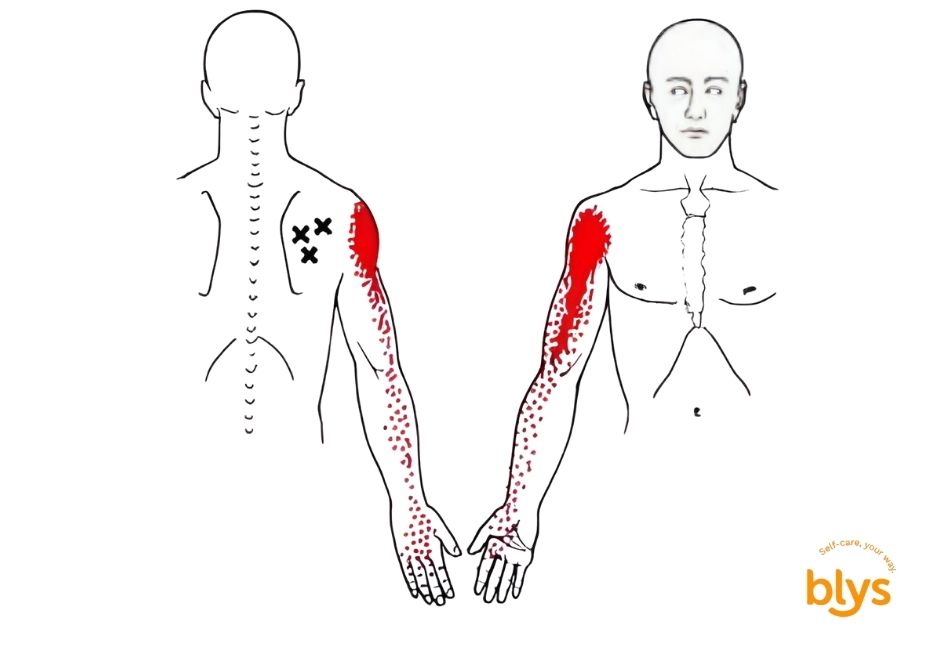 Subscapularis Trigger Points
Subscapularis Trigger Points
The Subscapularis is the biggest muscle in the rotator cuff and helps the shoulder work properly. When there are trigger points in this muscle, it can cause pain and discomfort in the front of the shoulder.
Upper Trapezius Muscle Knots
The Upper Trapezius muscle is a prominent muscle that spans from the neck to the shoulders and upper back. When trigger points develop within this muscle, they can lead to considerable discomfort in the neck and shoulders. Specifically, trigger points in the left Upper Trapezius are commonly associated with pain in the left shoulder, while those in the right Upper Trapezius can result in pain on the right side.
Supraspinatus
The Supraspinatus muscle is an essential part of the rotator cuff, significantly contributing to shoulder movement. When trigger points develop in the Supraspinatus, they can lead to pain in the shoulder area, particularly during arm movement.
Teres Minor and Teres Major
The Teres Minor and Teres Major muscles contribute to shoulder movements as well. When trigger points occur in these muscles, they can result in shoulder pain, with the pain’s location reflecting the specific muscle that is affected.
Benefits of Trigger Point Massage for Shoulder Pain
Pain Reduction Through Trigger Point Therapy
Trigger point massage effectively targets tight knots in the muscles that contribute to shoulder pain. By applying focused pressure to these trigger points, the therapy helps release tension and alleviate discomfort, providing both immediate relief and long-term benefits.
Improved Shoulder Mobility and Flexibility
This type of massage can greatly enhance shoulder mobility and flexibility by loosening tight muscles and fascia. As trigger points are released, the range of motion in the shoulder joint improves, making it easier to perform daily activities and engage in physical exercise. It also promotes better posture and movement efficiency.
Enhanced Blood Circulation
Trigger point massage stimulates blood flow to the affected areas, which is crucial for healing and recovery. Improved circulation delivers more oxygen and nutrients to the muscles, helping to reduce inflammation and promote overall muscle health.
Check out our in-depth guide on Trigger Point Therapy vs. Deep Tissue Massage to understand their unique benefits and when to choose each for optimal muscle recovery and pain relief.
Techniques for Performing Trigger Point Massage for Shoulder Pain
Professional Trigger Point Therapy for Shoulder Pain
There are about ten muscle groups that can cause pain in the shoulders, but the most commonly affected muscle groups are infraspinatus, subscapularis, and trapezius. The professional trigger point therapist can identify and target these specific muscle groups to release tension, alleviate pain, and restore proper function through techniques such as manual pressure, stretching, and myofascial release.
For a professional trigger point massage at your convenience, check out Blys and book a mobile trigger point massage session now!
Self-Massage Techniques for Shoulder Trigger Points
Using Massage Tools (Massage Balls, Foam Rollers)
According to the Physio Company in London, you can use massage balls to effectively relieve tension in the shoulder area. With your back against a wall, place the ball between your neck and shoulder blade. Gently lean into the wall and roll up and down or sideways. Hold still to release any knots as you find them. Like massage balls, you can also use foam rollers to relieve shoulder pain.
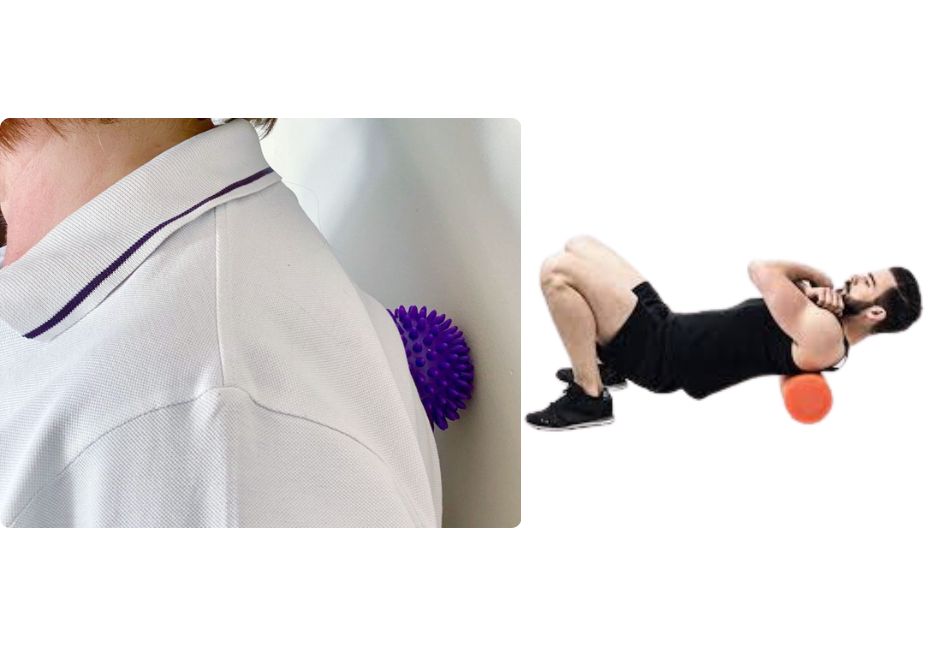 Manual Pressure Application for Shoulder Muscle Knots
Manual Pressure Application for Shoulder Muscle Knots
To alleviate shoulder muscle knots, apply gentle yet firm pressure with your thumbs and fingers, using small circular motions while maintaining relaxed breathing. This method will effectively promote muscle relaxation and relieve tension.
Frequency and Duration for Effective Results
Focus on locating the knot and massage it for 30 to 60 seconds, applying steady pressure with slow, intentional strokes that follow the muscle fibers.
Precautions and Considerations
When to Seek Professional Help for Shoulder Pain
If you are experiencing shoulder pain, it is important to recognize the signs that indicate the need for professional medical help. Here are the key points to consider:
- Shoulder pain accompanied by fever, swelling, or redness.
- Significant pain when moving the shoulder, either by yourself or with assistance.
- Pain lasting more than 2 to 4 weeks despite home treatment.
- Swelling of the shoulder.
- Red or blue discoloration of the skin in the shoulder area.
- Deformity of the shoulder joint after a fall.
- Inability to use the shoulder or move the arm away from the body.
- Intense pain.
- Sudden swelling.
- Ongoing pain, especially if accompanied by a popping sound or tearing sensation resulting in loss of function.
- Persistent shoulder pain lasting longer than a few weeks that cannot be relieved by home remedies.
Understanding Potential Discomfort from Trigger Point Therapy
Trigger points are small, sensitive areas in tight muscles that can cause pain. After getting an injection, you might feel some soreness, bruising, or a burning sensation when the needle is inserted. While you may feel a little tenderness afterwards, you can return to your normal activities right away.
Contraindications for Trigger Point Massage
| Osteoporosis | Obstructive edema |
| Acute rheumatoid arthritis | Known or suspected cancerous tumors |
| Degenerative joint disease | Widespread pain conditions (e.g., fibromyalgia) |
| Advanced diabetes | Endocrine disorders |
| Hyperesthesia | Open wound or injury |
| Blood clots | Active infection |
| Goiter | Fever |
| Recent surgery | Severe osteoporosis |
Note: Caution is advised for patients taking anticoagulants, pregnant patients, and those with indistinguishable anatomical landmarks. Trigger point therapy is also not suitable for clients seeking a relaxation massage.
Integrating Trigger Point Massage into a Comprehensive Shoulder Pain Management Plan
Complementary Therapies for Shoulder Pain Relief
| Physical Therapies | Medical Treatments | Alternative Medicine | Additional Therapies |
| Physical Therapy | Medical Acupuncture | Acupressure | Shoulder Stretches |
| Shoulder External Rotation | Medical Massage | Acupuncture | Osteopathic Manipulation |
| Scapular Retraction | Ozone Therapy | Hydrotherapy | Regenerative Prolotherapy Injections |
| – | Traditional Chinese Herbal Medicine | Zen | Dry Needling |
| – | Red Light Therapy | Reflexology | Laser Therapy |
| – | Yoga and Tai Chi | Shock Wave Therapy |
Lifestyle Modifications to Prevent Shoulder Muscle Tension
Here’s a list of lifestyle modifications to prevent shoulder muscle tension:
- Watch Your Posture
- Stretch Regularly
- Take Breaks
- Exercise Your Shoulders
- Practice Good Ergonomics
- Avoid Pain-Exacerbating Activities
- Maintain a Healthy Weight
- Incorporate Stress-Reducing Activities
By following these modifications, you can help prevent shoulder muscle tension and promote overall shoulder health.
Frequently Asked Questions (FAQs)
What Causes Trigger Points in Shoulder Muscles?
Trigger points in shoulder muscles are often caused by muscle overuse, poor posture, and stress, leading to muscle tension and pain.
Can I Perform Trigger Point Massage for Shoulder Pain Myself?
Yes, you can perform self-trigger point massage using tools like foam rollers or massage balls, but be cautious with the pressure applied.
How Often Should I Do Trigger Point Therapy for Shoulder Pain?
It is generally recommended to perform trigger point therapy 2 to 3 times a week, adjusting based on your comfort and pain levels.
Are There Any Risks Associated with Trigger Point Massage?
Risks include bruising, increased soreness, or muscle strain, especially if too much pressure is applied or if there are underlying medical conditions.
How Long Does It Take to Experience Relief from Shoulder Pain?
Relief from shoulder pain can vary; some may feel immediate improvement, while others might need several sessions over weeks for significant relief.
Conclusion
Trigger point massage can be a highly effective method for relieving shoulder pain. By understanding and applying these techniques, you can manage discomfort and improve your overall shoulder health. Always consult with a healthcare professional if pain persists or worsens.

